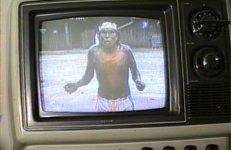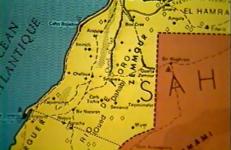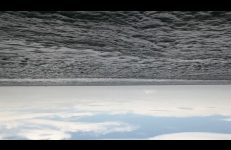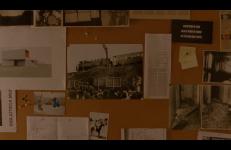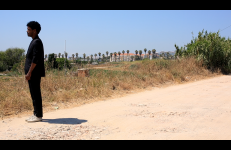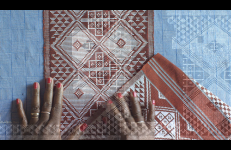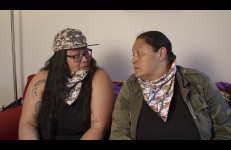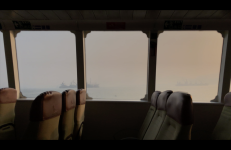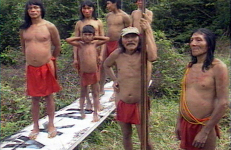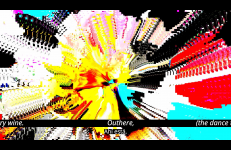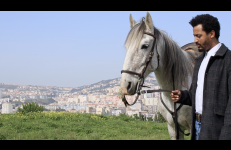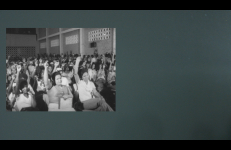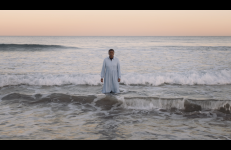Pemp traces the 25-year struggle of the Parakatêjê (Gavião) to maintain autonomy in the face of huge development projects in the south of Pará. From the initial recovery of their lands in 1957 through dealings with FUNAI in the 1970s and the appropriation of Brazil nut monopolies to their current negotiations with the government, Pemp shows the Parakatêjê’s most precious project; the preservation of their ceremonies and songs. The Kokrenum, chief and keeper of the group’s traditions, uses video to transmit them to future generations.
Post-colonialism
Pochonovela is a bilingual, bicultural blend of Latin America’s and the United States’ most popular television genres—the telenovela and the sitcom, respectively. The humor and madness of life in East Los Angeles are captured here in performances by members of the Los Angeles-based comedy troupe, Chicano Secret Service, and other U.S. Latino actors. This provocative comedy touches on political, social, cultural, linguistic, and family issues attendent to the cross cultural life of Mexican Americans living near or on the border—both psychologically and geographically.
“A documentary about the Arkestra, but it's one whose presentation reflects the multilevel approach Sun Ra had to music and life in general. Jump cuts and split screens dot the visual stream with home movie footage from the Arkestra in Egypt during the 1970s to the Arkestra of today led by Marshall Allen. Director Ephraim Asili wisely divides the 40 minutes into distinct chapters, illustrating each with band interviews, live footage, visuals of planets and NASA launches, and his voice quoting writings from Ra.
A historical analysis of the on-going war in the Western Sahara. Liza Bear interviews Abdullah Majdid, the Polisario Front's United Nations representative. The tape addresses Morocco's U.S.-backed military effort to subjugate the indigenous Sahrawi population and annex one of the world's largest phosphate deposits, as well as the Sahrawis' conditions for a referendum.
“I could do wonders if I didn't have a body. But the body grabs me, it slows me, it enslaves me.”
-- Ponce de Léon
“I could do wonders if I didn't have a body. But the body grabs me, it slows me, it enslaves me.”
-- Ponce de Léon
Applying the same economy used in César's other films — one shot which uses the duration of an entire 16mm film reel — Porto 1975 is a tracking shot that unfolds at the social housing complex Cooperativa das Águas Férreas da Bouça, designed by Álvaro Siza Vieira as an integral part of the Ambulatory Service of Social Support (SAAL, 1972–76). The work's construction was initiated in 1975, but only completed in 2006.
Portuguese House is a journey throughout Lisbon, visiting the houses built by African communities from the Portuguese ex-colonies that have already been demolished. These houses, which were founded on dreams and not on drawings, thus became visible evidence of the right to housing, the right to build and to live in a house. Town planning and architecture are luxuries that do not guarantee access to happiness, in the same way that their absence does not invalidate it.
A caricature of a professor teaching English to non-native speakers. Her mannerisms, her accent, the content of her speech—all are absurd, in the tradition of an Ionesco character. Images of the professor alternate with collages, many taken from Bobe’s other works. Through its ironic humor, La Profesora foregrounds the absurdity of teaching English in a country where many cannot read their native language. The prevalence of the English language in post- and neo-colonial societies is thus called into question, both politically and socially.
In the beginning was the weave, and the transmission of its workings, a curse of mortality—so ends Quantum Creole with the fabulous words of the Papel weaver, Zé Interpretador.
California has been multicultural for at least 100 years, home to Indians, Spaniards, and Anglos. An 1884 romance novel, in fact, paired a half-European/half-Indian woman with the son of a Luiseño Indian chief. This experimental video essay examines the conventional wisdom on mixing of the races and includes popular movie images from Elvis Presley’s film Flaming Star, The Last of the Mohicans, and West Side Story.
Reclamation is a documentary-style imagining of a post-dystopian future in Canada after massive climate change, wars, pollution, and the after-effects of the large-scale colonial project which has now destroyed the land. When Indigenous people are left behind after a massive exodus by primarily privileged white settlers who have moved to Mars, the original inhabitants of the land cope by trying to restore and rehabilitate the beautiful planet they belong to.
A meditation on maritime trade routes, SEA – SHIPPING – SUN is a short film directed by Tiffany Sia (b. Hong Kong) and Yuri Pattison (b. Dublin) shot over the span of two years to render a simulated duration of a day, beginning at twilight and closing at sunset. The film is set against shipping forecasts from archival BBC Radio 4 broadcasts. The sun emerges and disappears, again and again.
A meditation on maritime trade routes, SEA – SHIPPING – SUN is a short film directed by Tiffany Sia (b. Hong Kong) and Yuri Pattison (b. Dublin) shot over the span of two years to render a simulated duration of a day, beginning at twilight and closing at sunset. The film is set against shipping forecasts from archival BBC Radio 4 broadcasts. The sun emerges and disappears, again and again.
Sea In The Blood is a personal documentary about living with illness, tracing the relationship of the artist to thalassemia in his sister Nan, and AIDS in his partner Tim. At the core of the piece are two trips. The first is in 1962, when Richard went from Trinidad to England with Nan to see a famous hematologist interested in her unusual case. The second is in 1977 when Richard and Tim made the counterculture pilgrimage from Europe to Asia. The relationship with Tim blossomed, but Nan died before their return.
A remarkable work about the struggle of the Waiãpi tribe, an indigenous people of Brazil, to combat the encroachment of prospectors on their land. Using performative storytelling as well as documentary footage, the tape builds a history of the many negotiations and public performances that the Waiãpi engaged in with the Brazilian government to demarcate and preserve some of their land, and to regain control of their resources.
Directed by Vincent Carelli and Dominique Gallois.
In Waiãpi with English subtitles.
A remarkable work about the struggle of the Waiãpi tribe, an indigenous people of Brazil, to combat the encroachment of prospectors on their land. Using performative storytelling as well as documentary footage, the tape builds a history of the many negotiations and public performances that the Waiãpi engaged in with the Brazilian government to demarcate and preserve some of their land, and to regain control of their resources.
Directed by Vincent Carelli and Dominique Gallois.
In Waiãpi with English subtitles.
"Love at first sight, one night, down at Silverror’s Saloon!" Mickey R Mahoney and jonCates direct Silverror’s Saloon, the next film in the 鬼鎮 (Ghosttown) Glitch Western series of films and games. Written by Emily Mercedes Rich and jonCates, this experimental film queers, glitches, and questions the Western film genre. We encounter characters caught in a glitched cinematic magic moment: a love scene. First dance with a stranger. Home and far from home.
"Love at first sight, one night, down at Silverror’s Saloon!" Mickey R Mahoney and jonCates direct Silverror’s Saloon, the next film in the 鬼鎮 (Ghosttown) Glitch Western series of films and games. Written by Emily Mercedes Rich and jonCates, this experimental film queers, glitches, and questions the Western film genre. We encounter characters caught in a glitched cinematic magic moment: a love scene. First dance with a stranger. Home and far from home.
Fulbeck force-feeds the viewer scores of all-too-familiar Asian female/Caucasian male pairings in Hollywood films, and combines them with contemporary excerpts from best-selling novels, magazines, and dating services. Some Questions For 28 Kisses delves into the causes and purposes of these created images and their relation to interracial dating, ethnic fetishes, race and gender wars, and Hapa identity.
“Leads the viewer on a delightfully rip-roaring jaunt through the Asian Pacific American psyche.”
-- Gerard Lim, Asian Week
In these seven short video performances directed by Isaac Artenstein, Gómez-Peña confronts Mexican-American culture clashes, stereotypes, and the Fourth World (immigrants). Speaking through a bullhorn or on the airwaves of mock-station Radio Latino FM, he broadcasts a message that will not be silenced.
In these seven short video performances directed by Isaac Artenstein, Gómez-Peña confronts Mexican-American culture clashes, stereotypes, and the Fourth World (immigrants). Speaking through a bullhorn or on the airwaves of mock-station Radio Latino FM, he broadcasts a message that will not be silenced.
South Circular first shows us two women, in the shadow of nondescript ruins over the Tagus river in Lisbon. Three disparate elements, then — a female pair, a structure in ruins and a river surrounding Lisbon and winding through the city’s outskirts — lay the foundation for a historical inventory of a military defense line that with time assumed a different role and another meaning.
Spell Reel is an archive of film and audio material from Bissau, Guinea-Bissau. On the verge of complete ruin, the footage testifies to the birth of Guinean cinema as part of the decolonising vision of Amílcar Cabral, the liberation leader who was assassinated in 1973.
Moving across the shores between Ceuta (Spain) and Tangier, Morocco, a man and woman discover the present borders and past archaeologies of these lands that were once one and now exist separately. Human shipwrecks meet the abyss of such separation. People are trapped in a limbo between Europe and the inhospitable forests of Morocco. In the incessant search for a better life, many die crossing the Mediterranean, a sea that has become a graveyard of unconquered lost hopes. The land is cut by barbed wires that do not let people in or out, constantly expelling and containing.




